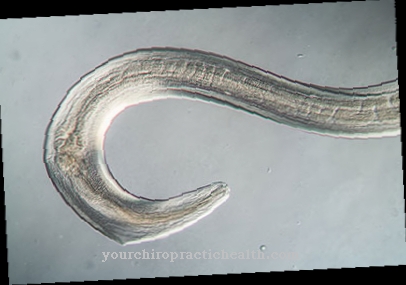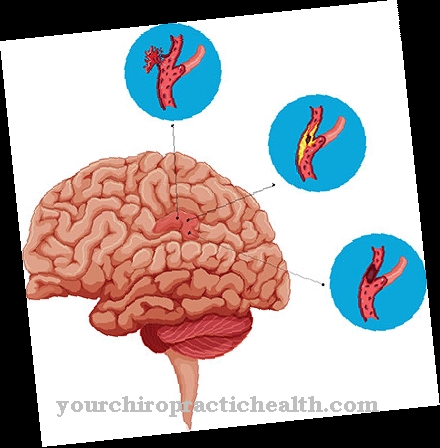The Blue diaper syndrome is a congenital metabolic disease with the main symptom tryptophan malabsorption. The lack of absorption by the intestine results in a conversion and excretion via the kidneys, so that the urine turns blue. Treatment is equivalent to intravenous tryptophan supplementation.
What is blue diaper syndrome?

© arttim - stock.adobe.com
Blue diaper syndrome is also known as tryptophan malabsorption syndrome. It is an extremely rare metabolic disease that is one of the innate metabolic disorders. The patients suffer from malabsorption of tryptophan. Tryptophan is an amino acid that patients with blue diaper syndrome can no longer absorb through the intestinal wall into the bloodstream.
The tryptophan remains in the intestine, where it is excreted via the kidneys after conversion processes. In contact with air, the substance turns blue. Hence the name of the blue diaper syndrome. All other symptoms of the symptom complex are also due to tryptophan malabsorption and the lack of the substance in the blood.
The blue diaper syndrome is sometimes referred to as familial hypercalcemia with the accompanying symptoms of nephrocalcinosis, hyperphosphaturia and indicanuria, which is caused by a disturbance in the absorption of tryptophan.
causes
The blue diaper syndrome is extremely rare and has not been fully researched because of its rarity. Nevertheless, the hereditary connections are now known. The exact inheritance of the disease is so far unclear. An autosomal recessive inheritance and an X-linked recessive inheritance are under discussion. The molecular biological cause of the syndrome is also still unknown.
There are many speculations about the cause, all of which presuppose a genetic mutation. Mutations of the L-type amino acid transporter 2, for example, are possible for the disease. The genes coding for this are SLC7A8 and LAT2, which are located on chromosome 14 in the gene locus q11.2.
Likewise conceivable causes would be mutations of the T-type amino acid transporter 1 on gene SLC16A10 and gene TAT1. These genes are located on chromosome 6 in the gene locus q21-q22. It is not known whether external factors such as exposure to toxins play a role in the development of the blue diaper syndrome.
Symptoms, ailments & signs
Blue diaper syndrome is associated with all of the symptoms of acquired tryptophan malabsorption. In addition to the lack of tryptophan in the blood, the patients suffer from severe hypercalcaemia, which is associated with nephrocalcinosis. Calcium salts are deposited in the kidney tissue of those affected and, if left untreated, can later lead to kidney failure.
In addition, the hydrogen ion excretion of patients is higher than in healthy people. The patients also excrete large amounts of phosphorus through the kidneys, so that one can speak of hyperphosphaturia. The most characteristic symptom of the disease, however, is the blue color of the diapers.
Since the intestine does not absorb the tryptophan, intestinal bacteria convert the amino acid to indole and its compounds. These substances are absorbed by the intestinal mucosa and migrate to the liver, where they are converted to indican. The indican is excreted renally in the urine and is responsible for the blue discoloration of the diapers.
diagnosis
The first suspected diagnosis of blue diaper syndrome overtakes the doctor by visual diagnosis or anamnestic as soon as the diaper is said to be blue. Since acquired tryptophan malabsorption is also associated with the symptoms of the blue diaper syndrome and no molecular genetic analysis is available for the hereditary form of such a metabolic disease, a corresponding suspected diagnosis can only be confirmed with difficulty.
Although blood tests can reveal a deficiency in the amino acid and hypercalcaemia, in the end, there can be no definite diagnosis until the responsible gene is identified. If several cases of the blue diaper syndrome are observed in a family, the diagnosis can, however, be considered certain.
Complications
Since the blue diaper syndrome is a congenital malabsorption of the amino acid tryptophan, this must be given to the affected children immediately upon detection of the disease. However, the patient's intestines cannot absorb the amino acid, which is why it is recommended to administer it directly into the blood. This form of therapy is inevitable, because tryptophan is an important component of countless processes in the human body and, among other things, it is involved in the formation of the tissue hormone serotonin.
If tryptophan malabsorption is left untreated, there is a serious risk of hypercalcaemia and renal insufficiency from the associated nephrocalcinosis. This can then make dialysis or even a donor organ necessary, which significantly limits the quality of life of the young patient. Many sufferers also have damage to the eyes, which is why complications can also arise in the area of ametropia.
Because it is still not clear what cause the blue diaper syndrome really has, there is no way to prevent the dangerous metabolic disorder. It is therefore imperative that parents contact the pediatrician immediately when they find the first blue-colored diaper in order to save the child from serious consequences.
When should you go to the doctor?
If a blue discoloration of the diaper is noticed, the child concerned should be taken to the pediatrician immediately. The doctor can then diagnose the blue diaper syndrome and confirm the diagnosis with the help of a blood test and anamnesis.
Immediate treatment is then required in any case. It is therefore advisable to consult a doctor at the first suspicion of the disease.Typical symptoms that need to be clarified immediately are, in addition to the blue color of the diapers, unusually frequent urination and sometimes pain when urinating.
Occasionally, other complaints occur and the affected child shows typical fever symptoms or looks exhausted. Therefore, with any symptoms that deviate from the norm, the pediatrician should be consulted.
If there are already cases of the disease in a family, the child and especially the stool should be examined as soon as possible after birth. An appropriate medical history enables a reliable diagnosis and facilitates the targeted treatment of the blue diaper syndrome.
Doctors & therapists in your area
Treatment & Therapy
A causal therapy is not available for patients with blue diaper syndrome as long as the causal gene has not been identified and gene therapy approaches have not reached the clinical phase. Therefore, the disease is treated more or less symptomatically. The supplementation of the amino acid tryptophan can play a major role in such treatment. Since the disease does not allow tryptophan to be absorbed in the intestine, the amino acid must be administered in a different way.
In this case, it can be given directly into the blood. The supplementation of the amino acid reduces all symptoms of the metabolic disorder. In extremely severe cases, the hypercalcaemia must be treated separately. Serum calcium can be reduced, for example, by increasing excretion, as can be achieved with a loop diuretic and glucocorticoids.
Symptoms like nephrocalcemia can only be treated by eliminating the hypercalcaemia. If the nephrocalcinosis has already led to renal insufficiency, this insufficiency must be treated separately. Treatment options range from dialysis to a transplant, depending on the severity of the insufficiency.
As a rule, the blue diaper syndrome is recognized early enough to be able to successfully prevent kidney failure by permanently lowering the calcium level. By supplementing tryptophan, hypercalcaemia will ideally no longer occur in the future.
Outlook & forecast
There is no prospect of a cure for blue diaper syndrome. The syndrome is a genetic misdirection that cannot be cured with the available medical and scientific possibilities. For legal reasons, interference with human genetics is not permitted, making the prospect of recovery impossible. There are also no alternative healing methods or self-healing processes of the organism that contribute to an improvement in health.
Without medical care for the consequences of blue diaper syndrome, the patient is at risk of serious complications. In severe cases, kidney organ failure occurs in untreated patients. This can lead to a sudden fatal course of the disease. The sick person needs a donor kidney as soon as possible in order to improve the quality of life and maintain well-being.
The survival of the sick person is assured by taking advantage of regular drug treatment. Although the healing does not occur, the patient with the syndrome can cope with life on their own. Overexertion and unnecessary stress are to be avoided as well as the consumption of alcohol or other harmful substances. If life is adapted to the needs of the organism and the lifestyle is made as healthy and sustainable as possible, the general health of the patient improves immensely.
prevention
The blue diaper syndrome has not yet been conclusively researched. Neither the exact cause nor the possible influencing factors have undoubtedly been identified. Without knowing the influencing factors, the complex of symptoms cannot be prevented. The low prevalence of the syndrome is mainly responsible for the poor research situation. Because of this low prevalence, the research situation is unlikely to change much in the near future.
Aftercare
For this extremely rare metabolic disease, medical follow-up is essential because of the possible consequences of the disease. The positive effect of the strict diet that the affected children are on must be checked regularly. However, an unsuitable diet with too much calcium and the amino acid tryptophan can lead to kidney damage.
The intravenous administration of tryptophan is preferable to the tryptophan given in the diet. The injection is usually carried out under medical supervision or by medically trained nursing staff. In order to keep the blue diaper syndrome under control, antibiotic therapy may be necessary if intestinal infections or bacterial infestation in the digestive system occur.
If the affected person already has kidney damage, the follow-up care must monitor the resulting hypercalcaemia and the prescribed loop diuretics and glucocorticoids. Follow-up care for blue diaper syndrome is made more difficult by the fact that tryptophan malabsorption has so far hardly been researched.
The metabolic disease is one of the very rare diseases. What is certain so far is heredity. Since the cause of the blue diaper syndrome may be a gene mutation, gene therapy can possibly achieve better treatment results in a few years. It remains to be seen whether medical follow-up care is necessary or whether the blue diaper syndrome can be treated prenatally.
You can do that yourself
Parents of children who suffer from blue diaper syndrome only need to ensure that the child takes the necessary medication regularly and does not show any noticeable symptoms or discomfort. If treatment is carried out early, the development of renal insufficiency can reliably be avoided.
In general, affected children have no symptoms or symptoms other than the blue urine that require treatment. In individual cases, however, symptoms of the gastrointestinal tract or even serious kidney problems can occur. Parents should monitor their child closely and alert the pediatrician immediately if they have any noticeable symptoms.
Despite its comparatively good prognosis, the disease can have an impact on the mental state of the parents, who often suffer from severe anxiety. A conscious examination of the blue diaper syndrome and its causes gives relatives a new perspective on the disease and makes it easier to deal with it.
Attending a self-help group or talking to other parents whose children have the metabolic disease can also help. Parents should address their questions and concerns to the responsible doctor and consult a therapist through him.






.jpg)

















.jpg)



